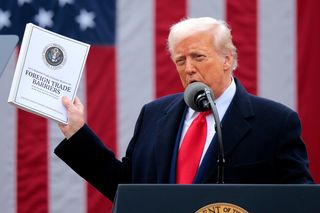I’m honored to share a few thoughts on how technology intersects with the economic security agenda – and indeed, in many ways why technology is at the core of the economic security debates, at least in the United States.
There has been quite a bit of discussion already about the 'small yard, high fence' approach. Let me see if I can further abuse this poor metaphor and beat this horse a bit more dead.
The 'run faster' strategy
I want to start with a bit of a look back, at how tech policy has evolved over the last two to three decades, with a particular focus on how the US government has managed the balance between economic growth and innovation on the one hand and security interests on the other hand, particularly within the context of the relationship with China.
And I’ll start with, the aughts and 2010s, the time just after China’s accession to the World Trade Organization (WTO). US policy had been geared at ensuring US technological leadership through a 'run faster' strategy.
The idea was that US tech firms had to have access to – and be competitive – in global markets, including importantly the China market.
This scale would give them the revenues they needed to plow back into R&D, which was the real secret sauce for remaining at the cutting edge of complex technologies.
There would be a virtuous cycle of markets leading to scale leading to innovation leading to US leadership across a range of technology sectors, which would allow US firms to continually 'run faster' than competitors elsewhere – including in China.
This was not just a sop to commercial interests. There was a real strategic logic to it. The US military was deeply dependent on commercial capabilities to power its platforms.
The military was a buyer, no longer a builder, and it did not drive markets in core technologies, such as chips, where it made up just a small percentage of global demand.
US security interests were dependent on US companies being the best globally, so that tech could be spun back into the military – an approach that had huge benefits for military innovation but also one that left the national security apparatus dependent on commercial markets.
During this period, defensive policies, such as export controls, were seen as a backstop, intended to ensure that the most advanced technologies were not used for military purposes in countries of concern.
There was also a belief and a policy intent to differentiate between civilian and military end uses or end users in China, with the goal of facilitating trade of dual-use goods for commercial purposes in most cases, so long as the United States was confident it was staying one to two generations ahead of China. This one to two generations idea was the original conception of the 'small yard, high fence' idea.
Changing geopolitical conditions
But by the mid 2010s, this strategy of running faster had begun to fray.
All of a sudden, it seemed, China had become a major technological player in its own right.
The West was taken by surprise, for example, when Huawei started to dominate global telecommunications networks and there was not a strong counterweight from the United States.
We were put on high alert when, in the Made in China 2025 vision, China declared its intentions to dominate strategic technology sectors, at the expense of the United States and other industrialised democracies
And there was increasing concern that not only was the playing field not level, it was unclear that the United States and its partners could use the usual tools to make it level.
After all, the United States had been trying all of that for years, through dialogues and trade litigation, with arguably limited success and increasingly high levels of frustration at China’s continued drift away from free market principles or competition on anything other than China’s own terms.
Amid this intensifying technological competition from China, there is another layer we need to add in, which is the security layer. Over this time when China’s technological might was growing, so to was their spirit of adventure in their foreign policy, the authoritarianism under Xi, and – importantly – their military capabilities.
I like to look at the annual US Department of Defense report on China’s military capabilities. If you look at this report in 2000, the year just before China acceded to the WTO, the defense department assessed that the “technological level of China’s defense industrial complex is too far behind that of the West to produce weaponry that could challenge a technologically advanced foe such as the United States ... for an indefinite period of time.”
Fast forward to more recent reports, and the assessment is fundamentally different. China's military modernization has yielded capabilities across maritime, aerospace, space, cyber, and nuclear domains that pose a genuine threat to the United States, and China may now be able to “fight and win wars against a “strong enemy” and to counter interventions by a third party in their periphery. Those are coded words but I think we all know what they mean.
When Trump took office in 2017, these were the dynamics his administration faced. The response was, as history now knows, far more aggressive and disruptive than his predecessor.
But I point out this origin story, of how these trends were present well before 2017, to make the point that the ground had already shifted in the geopolitical competition and that we’re not going back to the days of trying to encouraging China to be a responsible stakeholder in the international system.
We no longer think that we can change China. Our strategy has shifted in important and fundamental ways.
Current US strategy for managing the technology competition with China
Instead of changing China, or relying on China’s own economic self-interest to motivate it to change, which was the logic of the WTO accession, our strategy now relies much more heavily on efforts to constrain China from taking actions that are against US interests or that would undermine the international rules-based order.
Many of these efforts to constrain China are playing out in the technology competition.
So, what does that strategy look like today?
The clearest articulation of how the United States intends to compete with China technologically is in the 2022 speech given by Jake Sullivan, the President’s National Security Advisor, in which he declared that the United States must maintain “as large of a lead as possible” in key technologies that will be force multipliers for US national security interests and military advantage, and he specifically noted a set of compute related technologies, including AI, chips, and quantum information technologies.
With these remarks, Sullivan re-set the entire agenda for the technology competition.
No longer would the United States try to stay just a generation or two ahead of Chinese competitors; instead we would try to freeze them in place.
No longer would the United States try to differentiate between civilian and military purposes in China, which had become a complex if not outright impossible task.
Instead, the United States was publicly naming the zero sum competition for global leadership in the technologies that may matter most for future military competition, and declaring that any advance by China in these areas, whether civilian or military, was a de facto national security risk to the United States.
The speech was followed by a series of supporting regulatory actions, including wide-ranging and novel export controls on advanced AI, advanced chips, and advanced supercomputers, as well as proposed restrictions on US investments in China in these and related areas.
Combined with a revived US industrial policy, the strategy is pulling multiple policy levers to essentially shock the shape of critical technology supply chains into a more geopolitically desirable shape.
Will the US strategy work?
The new approach was not without its critics.
Industry, for one, was none too pleased, arguing that it runs exactly counter to the intuition of the 'run faster' strategy and would cost them important R&D resources. Though, candidly, one does feel a bit pressed to feel too sorry for companies such as Nvidia these days, given their stratospheric stock price.
It is also fair to say that most close US allies are not ready to go quite this far and to declare entire tech ecosystems off limits in China.
In part, this disconnect comes from a perception that the US measures are being taken for protectionist, rather than national security reasons.
To be clear, I don’t think that’s the case.
But it is also true that these actions, if effective, will have economic consequences for China.
The technology in the small yard is, by our own admission, the technology that will be fundamental to future economic prosperity and growth, as well as to future security interests.
So this yard is not so small after all.
But, there is that caveat – if they are effective, and there are quite a few reasons why they could fall short. While noting that I generally support the policies, let me now list all the reasons they could fail.
First, of course, is that this new policy of controls is predominantly a US approach so far.
While there has been some ad hoc alignment around semiconductor manufacturing equipment, the measures of US partners are not a one for one match with the US controls. It remains unclear whether the United States has achieved strategic alignment with partners on the right tech control approach or simply a limited tactical success
Without a broader base of international partners that align both strategically and tactically with the United States on tech controls, our so-called 'technology chokepoints' will become fragile over time.
Tech companies retain their place in global value chains through continuous, cut-throat competition and innovation.
Replacing a key company in a complex advanced tech supply chains is a complicated task, requiring a significant amount of patient investment and a high level of technical sophistication.
But it can be done.
There is often a sense in US policy circles that tech chokepoints can be weaponized similarly to how we use financial sanctions, which rely on the role of the US dollar in global finance, but this is mistaken, as companies are – over time – replaceable in a way that the US dollar is not.
Foreign firms backfilling for US firms in China is one problem, but it’s not the only one.
There may also be a high incentive for firms outside of China, in for example Europe or Asia, to design out US technology or components so that they don’t have to worry about being subjected to the long arm of U.S. export controls.
Designing out US tech is a perfectly rationale response if firms want to maintain commercial autonomy and if their own governments are not imposing similar controls.
We’ve seen this play before, in the classic case of US controls on satellite technology in the 90s.
And of course, China may simply innovate around the controls, and there is some evidence that they are doing this with a certain degree of success so far.
Chokepoint vs. catch-up technologies
These are the potential pitfalls for the US strategy related to chokepoint technologies where the United States has a clear advantage in global markets. But that’s not the only area of technology subject to intensified competition.
There are a range of technologies where China is in on par with – or in many cases ahead of – the United States. The question is not how to stay as far ahead as possible, but how to catch up.
These catch-up tech areas include a host of clean energy technologies, batteries, and legacy chips.
The United States has had to come up with a new playbook for catch-up technologies, and it’s included a mix of industrial policy support to spur domestic manufacturing and tariffs to protect against the onslaught of cheaply made or subsidized Chinese imports.
Interestingly, tariffs are being used in something of a pre-emptive way. For example, the United States will impose a 100% tariff on Chinese made electric vehicles to push back on Chinese over capacity, even though Chinese electric vehicles are not sold in the United States today.
The objective, of course, is to avoid creating a new dependency on China in clean energy supply chains as the United States advances its climate transition objectives, and thus these efforts have clear security as well as economic implications.
Whether it is catch-up technologies or chokepoint technologies, it is clear that the United States is trying to enact a hard pivot away from past policies of managing the technology competition with China.
I applaud the innovation and ambition of these efforts. But as I wrap up my comments, I want to leave us with two thoughts on how the United States, working with international partners, can round out its strategy.
Next steps to implement a stronger economic security agenda
First, in the United States, we need to engineer a re-orientation of our economic security bureaucracy – and I say this with love as a former bureaucrat.
The role that economic security is playing in US foreign policy has fundamentally changed over the last decade, but the institutions and capabilities and budgets of our economic agencies has remained fundamentally the same. That will not do.
We need economists, data scientists, and industry experts to project the impact of proposed controls and tell us if our current controls are working
We need strategists to envision how our economic security tools can be used in potential conflict scenarios.
We need negotiators who can work with international partners to build new institutions and coordination frameworks to align economic security policies among likeminded friends.
Today, we have none of that, and without it the economic security mission will fail.
Secondly, US economic security attempts will also fail if the United States does not match what has become a heavily defensive strategy with an affirmative vision of what U.S. leadership in the global economy can be in the economic security era.
And no, IPEF is not that vision, sorry to say, nor is that other Jake Sullivan speech at Brookings, which fundamentally misrepresented the contours of prior US trade policy as being all about tariffs, which isn’t quite right.
But it was right that trade policy needs to look different, and the question and really the challenge for this generation of trade and economic security experts is – what should it look like, if we are centering resiliency and security along with open markets?
I would argue that we need to shift away from a binary model that is based on the presumption of openness, with narrow room for exceptions related to national security.
That model is not fit for our geopolitical moment, and it also leaves itself open to abuse as governments start to shove all manner of actions under a national security framing.
In a new CNAS paper, called Disorderly Conduct: How US-China Competition Upended the International Economic Order and What the United States Can Do to Fix It, we argue that a possible reframing is around three categories of interests: hard power interests, involving economic activities that matter for US military capabilities and in which we should seek overmatch; resiliency interests, which relate to the continued functioning of the US economy and society; and commercial interests, involving everything else and where government interventions should be minimal.
Each of these will have a different competitive character, with different policy goals and policy instruments that would be applicable in pursuit of these interests.
The paper calls for the United States to engage with international partners on a deliberate effort to create new norms around government interventions related to hard power and resiliency interests in the interest of creating a new global economic order that meets today’s geopolitical conditions.
This new order would have a role for the WTO, as the baseline standard for engaging in rules-based trade, but would also imagine a lot of action outside the WTO, including a much more ambitious agenda of norms-building and in some cases institution-building among like-minded allies.
It would involve doing things like, for example, creating economic security agreements to enhance cooperation in key strategic sectors, aligning both traditional trade tools (e.g., tariffs and market access) with alignment on defensive tools (e.g., export controls), bringing these policy levers together in a way that has never been done before in a trade agreement.
I can’t imagine a better country to start with than Australia, given the strategic alignment, the building blocks of an existing FTA (which could use some updating), AUKUS, investment screening cooperation, etc. How do we build on that, and create a strong alliance that recognizes and addresses both our common and sometimes our very different economic security needs.
It is only by working together, hand in hand, with Australia and our closest allies that the United States can reset the global economic order to meet the needs of our economic security era, and I hope we take the opportunity.
Thank you.









